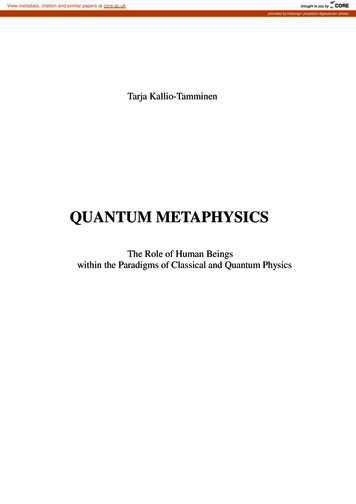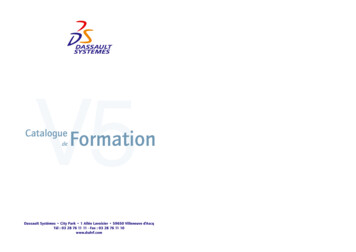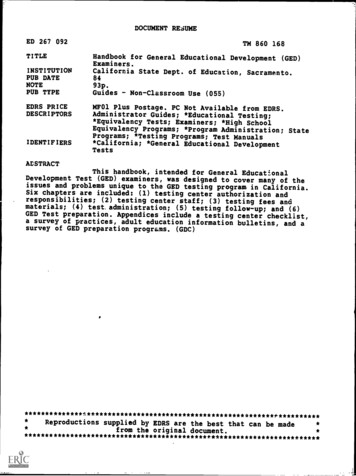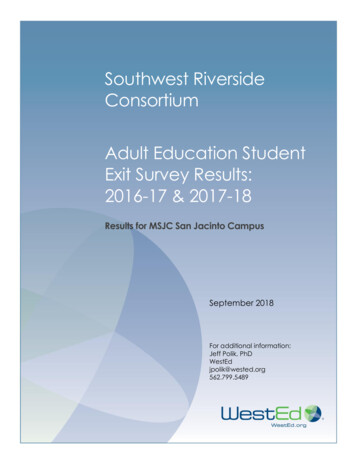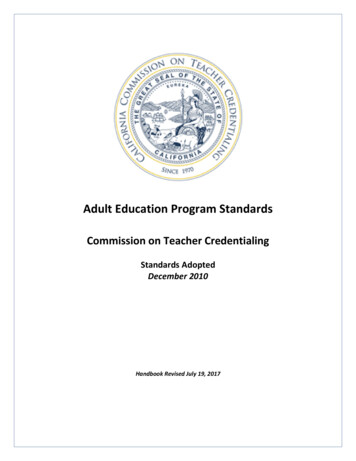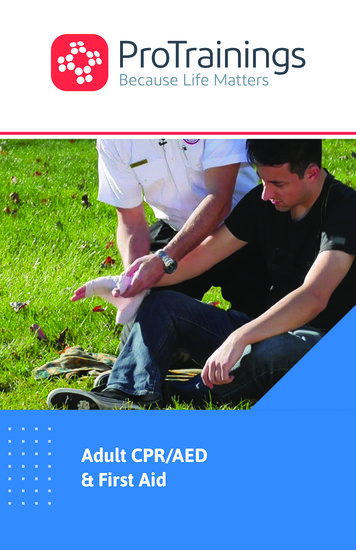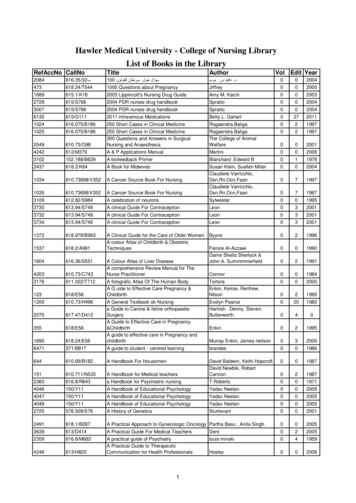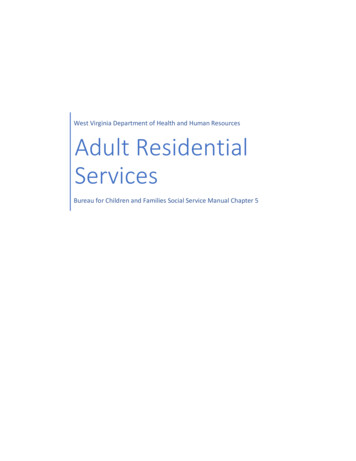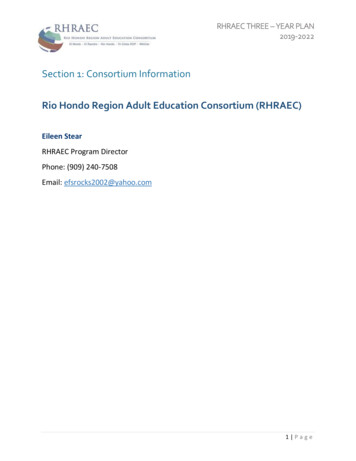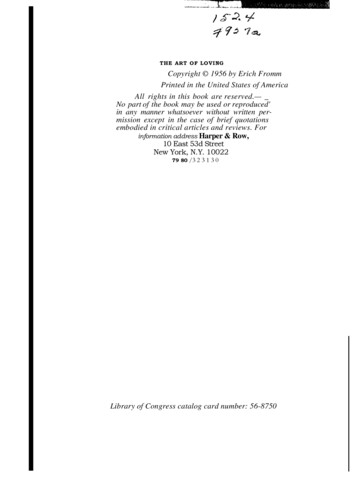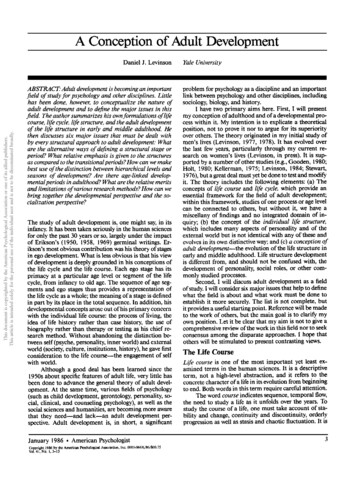
Transcription
A Conception of Adult DevelopmentThis document is copyrighted by the American Psychological Association or one of its allied publishers.This article is intended solely for the personal use of the individual user and is not to be disseminated broadly.Daniel J. LevinsonABSTRACT: Adult development is becoming an importantfield of study for psychology and other disciplines. Littlehas been done, however, to conceptualize the nature ofadult development and to define the major issues in thisfield. The author summarizes his ownformulations of lifecourse, life cycle, life structure, and the adult developmentof the life structure in early and middle adulthood. Hethen discusses six major issues that must be dealt withby every structural approach to adult development: Whatare the alternative ways of defining a structural stage orperiod? What relative emphasis is given to the structuresas compared to the transitional periods? How can we makebest use of the distinction between hierarchical levels andseasons of development? Are there age-linked developmental periods in adulthood? What are the relative meritsand limitations of various research methods? How can webring together the developmental perspective and the socialization perspective?The study of adult development is, one might say, in itsinfancy. It has been taken seriously in the human sciencesfor only the past 30 years or so, largely under the impactof Erikson's (1950, 1958, 1969) germinal writings. Erikson's most obvious contribution was his theory of stagesin ego development. What is less obvious is that his viewof development is deeply grounded in his conceptions ofthe life cycle and the life course. Each ego stage has itsprimacy at a particular age level or segment of the lifecycle, from infancy to old age. The sequence of age segments and ego stages thus provides a representation ofthe life cycle as a whole; the meaning of a stage is definedin part by its place in the total sequence. In addition, hisdevelopmental concepts arose out of his primary concernwith the individual life course: the process of living, theidea of life history rather than case history, the use ofbiography rather than therapy or testing as his chief research method. Without abandoning the distinction between self (psyche, personality, inner world) and externalworld (society, culture, institutions, history), he gave firstconsideration to the life course--the engagement of selfwith world.Although a good deal has been learned since the1950s about specific features of adult life, very little hasbeen done to advance the general theory of adult development. At the same time, various fields of psychology(such as child development, gerontology, personality, social, clinical, and counseling psychology), as well as thesocial sciences and humanities, are becoming more awarethat they need--and lack--an adult development perspective. Adult development is, in short, a significantJanuary 1986 9 American PsychologistCopyright 1986 by the American Psychological Association, Inc. 0003-066X/86/ 00.75Vol. 41, No. 1, 3-13Yale Universityproblem for psychology as a discipline and an importantlink between psychology and other disciplines, includingsociology, biology, and history.I have two primary aims here. First, I will presentmy conception of adulthood and of a developmental process within it. My intention is to explicate a theoreticalposition, not to prove it nor to argue for its superiorityover others. The theory originated in my initial study ofmen's lives (Levinson, 1977, 1978). It has evolved overthe last few years, particularly through my current research on women's lives (Levinson, in press). It is supported by a number of other studies (e.g., Gooden, 1980;Holt, 1980; Kellerman, 1975; Levinson, 1984; Stewart,1976), but a great deal must yet be done to test and modifyit. The theory includes the following elements: (a) Theconcepts of life course and life cycle, which provide anessential framework for the field of adult development;within this framework, studies of one process or age levelcan be connected to others, but without it, we have amiscellany of findings and no integrated domain of inquiry; (b) the concept of the individual life structure,which includes many aspects of personality and of theexternal world but is not identical with any of these andevolves in its own distinctive way; and (c) a conception ofadult development--the evolution of the life structure inearly and middle adulthood. Life structure developmentis different from, and should not be confused with, thedevelopment of personality, social roles, or other commonly studied processes.Second, I will discuss adult development as a fieldof study. I will consider six major issues that help to definewhat the field is about and what work must be done toestablish it more securely. The list is not complete, butit provides a useful starting point. Reference will be madeto the work of others, but the main goal is to clarify myown position. Let it be clear that my aim is not to give acomprehensive review of the work in this field nor to seekconsensus among the disparate approaches. I hope thatothers will be stimulated to present contrasting views.The Life CourseLife course is one of the most important yet least examined terms in the human sciences. It is a descriptiveterm, not a high-level abstraction, and it refers to theconcrete character of a life in its evolution from beginningto end. Both words in this term require careful attention.The word course indicates sequence, temporal flow,the need to study a life as it unfolds over the years. Tostudy the course of a life, one must take account of stability and change, continuity and discontinuity, orderlyprogression as well as stasis and chaotic fluctuation. It is
This document is copyrighted by the American Psychological Association or one of its allied publishers.This article is intended solely for the personal use of the individual user and is not to be disseminated broadly.not enough to focus solely on a single moment; nor is itenough to study a series of three or four moments widelyseparated in time, as is ordinarily done in longitudinalresearch. It is necessary, in Robert White's (1952) felicitous phrase, to examine "lives in progress" and to followthe temporal sequence in detail over a span of years.The word life is also of crucial importance. Researchon the life course must include all aspects of living: innerwishes and fantasies; love relationships; participation infamily, work, and other social systems; bodily changes;good times and bad--everything that has significance ina life. To study the life course, it is necessary first to lookat a life in all its complexity at a given time, to includeall its components and their interweaving into a partiallyintegrated pattern. Second, one must delineate the evolution of this pattern over time.The study of the life course has presented almostinsuperable problems to the human sciences as they arenow constituted. Each discipline has claimed as its specialdomain one aspect of life, such as personality, social role,or biological functioning, and has neglected the others.Every discipline has split the life course into disparatesegments, such as childhood or old age. Research hasbeen done from such diverse theoretical perspectives asbiological aging, moral development, career development,adult socialization, enculturation, and adaptation to lossor stress, with minimal recognition of their interconnections. The resulting fragmentation is so great that no discipline or viewpoint conveys the sense of an individuallife and its temporal course.The recognition is slowly dawning that the manyspecialties and theoretical approaches are not isolatedentities but aspects of a single field: the study of the individual life course. During the next decade, this studywill emerge as a new multidisciplinary field in the humansciences, linking the various disciplines. With the formation of a more comprehensive, systematic conceptionof the life course, the parts will become less isolated andeach part will enrich the others.The Life CycleThe idea of the life cycle goes beyond that of the lifecourse. In its origin this idea is metaphorical, not descriptive or conceptual. It is useful to keep the primaryimagery while moving toward more precise conceptualization and study. The imagery of "cycle" suggests thatthere is an underlying order in the human life course;although each individual life is unique, everyone goesthrough the same basic sequence. The course of a life isnot a simple, continuous process. There are qualitativelydifferent phases or seasons. The metaphor of seasons appears in many contexts. There are seasons in the year.Spring is a time of blossoming, and poets allude to youthI wouldlike to thank my wife,Judy D. Levinson,for her contributionsto the substance and spirit of this article and my colleague,Boris M.Astrachan, for his intellectual,moral, and administrativesupport.Correspondence concerningthis article should be addressed toDaniel J. Levinson,Departmentof Psychiatry,YaleUniversitySchoolof Medicine, 34 Park St., New Haven,CT 06519.4as the springtime of the life cycle. Summer is the seasonof greatest passion and ripeness. An elderly ruler is "'thelion in winter.'" There are seasons within a single d a y - dawn, noon, twilight, the full dark ofnightmeach havingits counterpart in the life cycle. There are seasons in love,war, politics, artistic creation, and illness.The imagery of the life cycle thus suggests that thelife course evolves through a sequence of definable forms.A season is a major segment of the total cycle. Changegoes on within each season, and a transition is requiredfor the shift from one to the next. Every season has itsown time, although it is part of and colored by the whole.No season is better or more important than any other.Each has its necessary place and contributes its specialcharacter to the whole.What are the major seasons in the life cycle? Neitherpopular culture nor the human sciences provide a clearanswer to this question. The modern world has no established conceptionmscientific, philosophical, religious, orliterary ofthe life cycle as a whole and of its componentphases. There is no standard language that demarcatesand identifies several gross segments of the life cycle. Thepredominant view, rarely stated explicitly, divides it intothree parts: (a) an initial segment of about 20 years, including childhood and adolescence (preadulthood); (b) afinal segment starting at around 65 (old age); and (c) between these segments, an amorphous time vaguely knownas adulthood.A good deal is known about the preadult years,which for a century have been the main province of thefield of human development. The developmental perspective has been of crucial importance here. The idea isnow accepted that in the first 20 years or so all humanbeings go through an underlying sequence of p e r i o d s prenatal, infancy, early childhood, middle childhood,pubescence, and adolescence. Although all children gothrough common developmental periods, they grow ininfinitely varied ways as a result of differences in biological, psychological, and social conditions. In its concreteform, each individual life course is unique. The study ofpreadult development seeks to determine the universalorder and the general developmental principles that govern the process by which human lives become increasinglyindividualized.Historically, the great figures in the study of childdevelopment, such as Freud and Piaget, have assumedthat development is largely completed at the end of adolescence. Given these assumptions, they had no basisfor concerning themselves with the possibilities of adultdevelopment or with the nature of the life cycle as a whole.An impetus to change came in the 1950s when geriatricsand gerontology were established as fields of human service and research. Unfortunately, gerontology has notgone far in developing a conception of the life cycle. Onereason, perhaps, is that it skipped from childhood to oldage without examining the intervening adult years. Present understanding of old age will be enhanced when moreis known about adulthood; thus, old age can be connectedmore organically to the earlier seasons.January 1986 9 American Psychologist
This document is copyrighted by the American Psychological Association or one of its allied publishers.This article is intended solely for the personal use of the individual user and is not to be disseminated broadly.There is now very little theory, research, or culturalwisdom about adulthood as a season (or seasons) of thelife cycle. We have no popular language to describe aseries of age levels after adolescence. Words such as youth,maturity, and middle age are ambiguous in their age linkages and meanings. The ambiguity of language stems fromthe lack of any cultural definition of adulthood and howpeople's lives evolve within it. In the human sciences,too, we have no adequate conception of the nature ofadulthood. We have a detailed picture of many trees butno view of the forest and no map to guide our journeythrough it.I turn now to my own view ofthe life cycle. It derivesfrom my research and draws upon the work of earlierinvestigators such as Erikson (1950, 1969), Jung, vonFranz, Henderson, Jacobi, and Jaffe (1964), Neugarten(1968), Ortega y Gasset (1958), and van Gennep (1960).(For a fuller review, see Levinson & Gooden, 1985.)Eras: The Macrostructure of the Life CycleI conceive of the life cycle as a sequence of eras. Eachera has its own biopsychosocial character, and each makesits distinctive contribution to the whole. There are majorchanges in the nature of our lives from one era to thenext, and lesser, though still crucially important, changeswithin eras. They are partially overlapping: A new erabegins as the previous one is approaching its end. A crossera transition, which generally lasts about five years, terminates the outgoing era and initiates the next. The erasand the cross-era transitional periods form the macrostructure of the life cycle, providing an underlying orderin the flow of all human lives yet permitting exquisitevariations in the individual life course.Each era and developmental period begins and endsat a well-defined modal age, with a range of about twoyears above and below this average. The idea of age-linkedphases in adult life goes against conventional wisdom.Nevertheless, these age findings have been consistentlyobtained in the initial research and in subsequent studies.The idea of age-linked eras and periods now has the statusof an empirically grounded hypothesis that needs furthertesting in various cultures.The first era, Preadulthood, extends from conceptionto roughly age 22. During these "formative years" theindividual grows from highly dependent, undifferentiatedinfancy through childhood and adolescence to the beginnings of a more independent, responsible adult life. It isthe era of most rapid biopsychosocial growth. The firstfew years of life provide a transition into childhood. During this time, the neonate becomes biologically and psychologically separate from the mother and establishes theinitial distinction between the "me" and the "not m e " - the first step in a continuing process of individuation.The years from about 17 to 22 constitute the EarlyAdult Transition, a developmental period in whichpreadulthood draws to a close and the era of early adulthood gets underway. It is thus part of both eras, and notfully a part of either. A new step in individuation is takenas the budding adult modifies her or his relationshipsJanuary 1986 9 American Psychologistwith family and other components of the preadult worldand begins to form a place as an adult in the adult world.From a childhood-centered perspective, one can say thatdevelopment is now largely completed and the child hasgained maturity as an adult. The field of developmental(i.e., child) psychology has traditionally taken this view.Taking the perspective of the life cycle as a whole, however,we recognize that the developmental attainments of thefirst era provide only a base, a starting point from whichto begin the next. The Early Adult Transition represents,so to speak, both the full maturity of preadulthood andthe infancy of a new era. One is at best off to a shakystart, and new kinds of development are required in thenext era.The second era, early adulthood, lasts from aboutage 17 to 45 and begins with the Early Adult Transition.It is the adult era of greatest energy and abundance andof greatest contradiction and stress. Biologically, the 20sand 30s are the peak years of the life cycle. In social andpsychological terms, early adulthood is the season forforming and pursuing youthful aspirations, establishinga niche in society, raising a family, and as the era ends,reaching a more "senior" position in the adult world.This can be a time of rich satisfaction in terms of love,sexuality, family life, occupational advancement, creativity, and realization of major life goals. But there can alsobe crushing stresses. Most of us simultaneously undertakethe burdens of parenthood and of forming an occupation.We incur heavy financial obligations when our earningpower is still relatively low. We must make crucially important choices regarding marriage, family, work, andlife-style before we have the maturity or life experienceto choose wisely. Early adulthood is the era in which weare most buffeted by our own passions and ambitionsfrom within and by the demands of family, community,and society from without. Under reasonably favorableconditions, the rewards of living in this era are enormous,but the costs often equal or even exceed the benefits.The Midlife Transition, from roughly age 40 to 45,brings about the termination of early adulthood and thestart of middle adulthood. The distinction between thesetwo eras, and the concept of Midlife Transition as a developmental period that separates and connects them,are among the most controversial aspects of this schema.The research indicates, however, that the character of living always changes appreciably between early and middleadulthood (Holt, 1980; Gooden, 1980; Levinson, 1978,1984, in press). Similar observations, based on differentmethods and evidence, are given in the work of Jung,Ortega, Erikson and others, noted earlier. The process ofchange begins in the Midlife Transition (though the formsand degree of change vary enormously) and continuesthroughout the era. One developmental task of this transition is to begin a new step in individuation. To the extentthat this occurs, we can become more compassionate,more reflective and judicious, less tyrannized by innerconflicts and external demands, and more genuinely loving of ourselves and others. Without it, our lives becomeincreasingly trivial or stagnant.5
This document is copyrighted by the American Psychological Association or one of its allied publishers.This article is intended solely for the personal use of the individual user and is not to be disseminated broadly.The third era, middle adulthood, lasts from aboutage 40 to 65. During this era our biological capacities arebelow those o f early adulthood but are normally still sufficient for an energetic, personally satisfying and sociallyvaluable life. Unless our lives are hampered in some special way, most of us during our 40s and 50s become "senior members" in our own particular worlds, howevergrand or modest they may be. We are responsible notonly for our own work and perhaps the work of others,but also for the development of the current generation ofyoung adults who will soon enter the dominant generation.The next era, late adulthood, starts at about age 60.The Late Adult Transition, from 60 to 65, links middleand late adulthood and is part of both. I will not discusslate adulthood here. My speculations regarding this era(and a subsequent one, late late adulthood) are given inLevinson (1978).The Life Structure and ItsDevelopmentin AdulthoodMy approach to adult development grows out of, and isshaped by, the foregoing views regarding the life courseand the life cycle. I am primarily interested in apprehending the nature o f a person's life at a particular timeand the course of that life over the years. Personality attributes, social roles, and biological characteristics areaspects of a life; they should be regarded as aspects andplaced within the context of the life.The key concept to emerge from my research is thelife structure." the underlying pattern or design of a person'slife at a given time. It is the pillar of my conception ofadult development. When I speak of periods in adult development, I am referring to periods in the evolution ofthe life structure. I will first introduce the concept of lifestructure and then describe m y theory and findings aboutits evolution in adulthood.The meaning of this term can be clarified by a comparison o f life structure and personality structure. A theory of personality structure is a way of conceptualizinganswers to a concrete question: "What kind of personam I?" Different theories offer numerous ways of thinkingabout this question and of characterizing oneself or others;for example, in terms of traits, skills, wishes, conflicts,defenses, or values.A theory of life structure is a way of conceptualizinganswers to a different question: "What is my life likenow?" As we begin reflecting on this question, many others come to mind. What are the most important parts ofmy life, and how are they interrelated? Where do I investmost of my time and energy? Are there some relationships--to spouse, lover, family, occupation, religion, leisure, or whatever--that I would like to make more satisfying or meaningful? Are there some things not in mylife that I would like to include? Are there interests andrelationships, which now occupy a minor place, that Iwould like to make more central?In pondering these questions, we begin to identifythose aspects of the external world that have the greatest6significance to us. We characterize our relationship witheach of them and examine the interweaving of the variousrelationships. We find that our relationships are imperfectly integrated within a single pattern or structure.The primary components of a life structure are theperson's relationships with various others in the externalworld. The other may be a person, a group, institutionor culture, or a particular object or place. A significantrelationship involves an investment of self (desires, values,commitment, energy, skill), a reciprocal investment bythe other person or entity, and one or more social contextsthat contain the relationship, shaping it and becomingpart of it. Every relationship shows both stability andchange as it evolves over time, and it has different functions in the person's life as the life structure itself changes.An individual may have significant relationships withmany kinds o f others. A significant other might be anactual person in the individual's current life. We need tostudy interpersonal relationships between friends, lovers,and spouses; between parents and their adult offspring atdifferent ages; between bosses and subordinates, teachersand students, and mentors and prot6g6s. A significantother might be a person from the past (e.g., Ezra Pound'svital relationship with the figure of Dante) or a symbolicor imagined figure from religion, myth, fiction, or privatefantasy. The other might not be an individual but mightbe a collective entity such as a group, institution, or socialmovement; nature as a whole, or a part of nature suchas the ocean, mountains, wildlife, whales in general, orMoby Dick in particular; or an object or place such as afarm, a city or country, "a room of one's own," or a bookor painting.The concept of life structure requires us to examinethe nature and patterning of an adult's relationships withall significant others and the evolution of these relationships over the years. These relationships are the stuff ourlives are made of. They give shape and substance to thelife course. They are the vehicle by which we live o u t - or bury--various aspects of our selves and by which weparticipate, for better or worse, in the world around us.Students of the life course seek to determine the characterof each relationship, its place within the person's evolvinglife, and the meaning of this life for the person and hisor her world.At any given time, a life structure may have manyand diverse components. We found, however, that onlyone or two components--rarely as many as three--occupy a central place in the structure. Most often, marriage-family and occupation are the central componentsof a person's life, although wide variations occur in theirrelative weight and in the importance of other components. The central components are those that have thegreatest significance for the self and the evolving lifecourse. They receive the largest share of the individual'stime and energy, and they strongly influence the characterof the other components. The peripheral components areeasier to change or detach; they involve less investmentof self and can be modified with less effect on the fabricof the person's life.January 1986 9 American Psychologist
This document is copyrighted by the American Psychological Association or one of its allied publishers.This article is intended solely for the personal use of the individual user and is not to be disseminated broadly.In terms of open systems theory, life structure formsa boundary between personality structure and socialstructure and governs the transactions between them. Aboundary structure is part of the two adjacent systems itconnects, yet is partially separate or autonomous. It canbe understood only if we see it as a link between them.The life structure mediates the relationship between theindividual and the environment. It is in part the cause,the vehicle, and the effect of that relationship. The lifestructure grows out of the engagement of the self and theworld. Its intrinsic ingredients are aspects of the self andaspects of the world, and its evolution is shaped by factorsin the self and in the world. It requires us to think conjointly about the self and the world rather than makingone primary and the other secondary or derivative. Atheory of life structure must draw equally upon psychology and the social sciences.Developmental Periods in Early and Middle AdulthoodIn tracing the evolution of the life structure in the livesof men and women, I have found an invariant basic pattern (with infinite manifest variations): The life structuredevelops through a relatively orderly sequence of agelinked periods during the adult years. I want to emphasizethat this is a finding, not an a priori hypothesis. It was assurprising to me as to others that the life structure shouldshow such regularity in its adult development, given theabsence of similar regularity in ego development, moraldevelopment, career development, and other specific aspects of the life.The sequence consists of an alternating series ofstructure-building and structure-changing (transitional)periods. Our primary task in a structure-building periodis to form a life structure and enhance our life within it:We must make certain key choices, form a structurearound them, and pursue our values and goals within thisstructure. Even when we succeed in creating a structure,life is not necessarily tranquil. The task of building astructure is often stressful indeed, and we may discoverthat it is not as satisfactory as we had hoped. A structurebuilding period ordinarily lasts 5 to 7 years, 10 at themost. Then the life structure that has formed the basisfor stability comes into question and must be modified.A transitional period terminates the existing lifestructure and creates the possibility for a new one. Theprimary tasks of every transitional period are to reappraise the existing structure, to explore possibilities forchange in the self and the world, and to move towardcommitment to the crucial choices that form the basisfor a new life structure in the ensuing period. Transitionalperiods ordinarily last about five years. Almost half ouradult lives is spent in developmental transitions. No lifestructure is permanent--periodic change is given in thenature of our existence.As a transition comes to an end, one starts makingcrucial choices, giving them meaning and commitment,and building a life structure around them. The choicesare, in a sense, the major product of the transition. Whenall the efforts of the transition are d o n e - - t h e struggles toJanuary 1986 9 American Psychologistimprove work or marriage, to explore alternative possibilities o f living, to come more to terms with the self-choices must be made and bets must be placed. One mustdecide "This I will settle for," and start creating a lifestructure that will serve as a vehicle for the next step inthe journey.Within early and middle adulthood, the developmental periods unfold as follows (see Figure 1). We havefound that each period begins and ends at a well-definedaverage age; there is a variation of plus or minus twoyears around the mean. (For a discussion of the age-linkages, see Issue 4 below.)1. The Early Adult Transition, from age 17 to 22,is a developmental bridge between preadulthood and earlyadulthood.2. The Entry Life Structure for Early Adulthood (22to 28) is the time for building and maintaining an initialmode of adult living.3. The Age 30 Transition (28 to 33) is an opportunityto reappraise and modify the entry structure and to createthe basis for the next life structure.4. The Culminating Life Structure for Early Adulthood (33 to 40) is the vehicle for completing this era andrealizing our youthful aspirations.5. The Midlife Transition (40 to 45) is another ofthe great cross-era shifts, serving both to terminate earlyadulthood and to initiate middle adulthood.6. The Entry Life Structure for Middle Adul
men's lives (Levinson, 1977, 1978). It has evolved over the last few years, particularly through my current re- search on women's lives (Levinson, in press). It is sup- ported by a number of other studies (e.g., Gooden, 1980; Holt, 1980; Kellerman, 1975; Levinson, 1984; Stewart,
